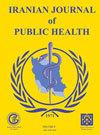Mucormycosis, New Causative Agents, and New Susceptible Populations: Review of Cases in a Tertiary Care Hospital in Iran (2007-2021)
IF 1.4
4区 医学
Q3 Medicine
引用次数: 0
Abstract
Background: Mucormycosis is an aggressive opportunistic fungal infection that afflicts patients with severe underlying immunosuppression, uncontrolled hyperglycemia and/or ketoacidosis, iron overload, and occasionally healthy patients who are inoculated with fungal spores through traumatic injuries. The epidemiology of mucormycosis has changed after the COVID-19 pandemic, with mucormycosis becoming the most common and the fatal coinfection Methods: In a retrospective, cross-sectional study, 82 hospitalized patients with a definite diagnosis of mucormycosis were reported from 2007 to 2021 in a referral, tertiary care center in Tehran, Iran Results: The number of post-COVID cases increased 4.6 times per year, with 41.5% of patients admitted during the two years of the pandemic. Mucormycosis was more common in women (57.3%), and the most common underlying diseases were diabetes (43.7%), both COVID-19 and diabetes (23.2%), cancer (11%), rheumatic diseases (7.3%), COVID-19 without other underlying diseases (6.1%), and transplantation (4.9%). Rhino-orbito-cerebral Mucormycosis (54.9%) followed by Sino-orbital infection (23.2%) was the most common presentation. There was a significant relationship between the use of immunosuppressive agents and the development of Mucormycosis (P<0.005) The average mortality was 41.5%, but this ratio decreased to 35% during the pandemic era. Conclusion: The COVID-19 pandemic caused a 4.6-fold increase in the number of mucormycosis patients, and there was a significant relationship between hyperglycemia, corticosteroid use, and mucormycosis. The death rate during the COVID-19 pandemic has decreased by 6.5%, and during the COVID period, the interval between the arrival of a patient with mucormycosis and the start of the correct treatment was significantly decreased.毛霉病、新的病原体和新的易感人群:2007-2021年伊朗一家三级医院病例回顾
背景:毛霉病是一种侵袭性的机会性真菌感染,患者有严重的潜在免疫抑制,高血糖和/或酮症酸中毒,铁超载,偶尔健康的患者通过创伤性损伤接种真菌孢子。新冠肺炎大流行后毛霉菌病的流行病学发生了变化,毛霉菌病成为最常见、最致命的合并感染
方法:在一项回顾性横断面研究中,报告了2007年至2021年在伊朗德黑兰三级保健中心转诊的82例明确诊断为毛霉病的住院患者。结果:新冠肺炎后病例数以每年4.6倍的速度增长,其中41.5%的患者在大流行两年内入院。Mucormycosis在女性中更为常见(57.3%),最常见的基础疾病是糖尿病(43.7%)、COVID-19合并糖尿病(23.2%)、癌症(11%)、风湿病(7.3%)、COVID-19无其他基础疾病(6.1%)和移植(4.9%)。鼻-眶-脑毛霉菌病(54.9%)其次是眶内感染(23.2%)是最常见的表现。免疫抑制剂的使用与毛霉病的发生有显著关系(P<0.005),平均死亡率为41.5%,但在大流行时期这一比例降至35%。结论:2019冠状病毒病大流行导致毛霉菌病患者人数增加4.6倍,高血糖、皮质类固醇使用与毛霉菌病有显著关系。COVID-19大流行期间的死亡率下降了6.5%,并且在COVID期间,毛霉菌病患者到达和开始正确治疗之间的间隔显着缩短。
本文章由计算机程序翻译,如有差异,请以英文原文为准。
求助全文
约1分钟内获得全文
求助全文
来源期刊

Iranian Journal of Public Health
医学-公共卫生、环境卫生与职业卫生
CiteScore
2.20
自引率
7.10%
发文量
0
审稿时长
2 months
期刊介绍:
Iranian Journal of Public Health has been continuously published since 1971, as the only Journal in all health domains, with wide distribution (including WHO in Geneva and Cairo) in two languages (English and Persian). From 2001 issue, the Journal is published only in English language. During the last 41 years more than 2000 scientific research papers, results of health activities, surveys and services, have been published in this Journal. To meet the increasing demand of respected researchers, as of January 2012, the Journal is published monthly. I wish this will assist to promote the level of global knowledge. The main topics that the Journal would welcome are: Bioethics, Disaster and Health, Entomology, Epidemiology, Health and Environment, Health Economics, Health Services, Immunology, Medical Genetics, Mental Health, Microbiology, Nutrition and Food Safety, Occupational Health, Oral Health. We would be very delighted to receive your Original papers, Review Articles, Short communications, Case reports and Scientific Letters to the Editor on the above mentioned research areas.
 求助内容:
求助内容: 应助结果提醒方式:
应助结果提醒方式:


